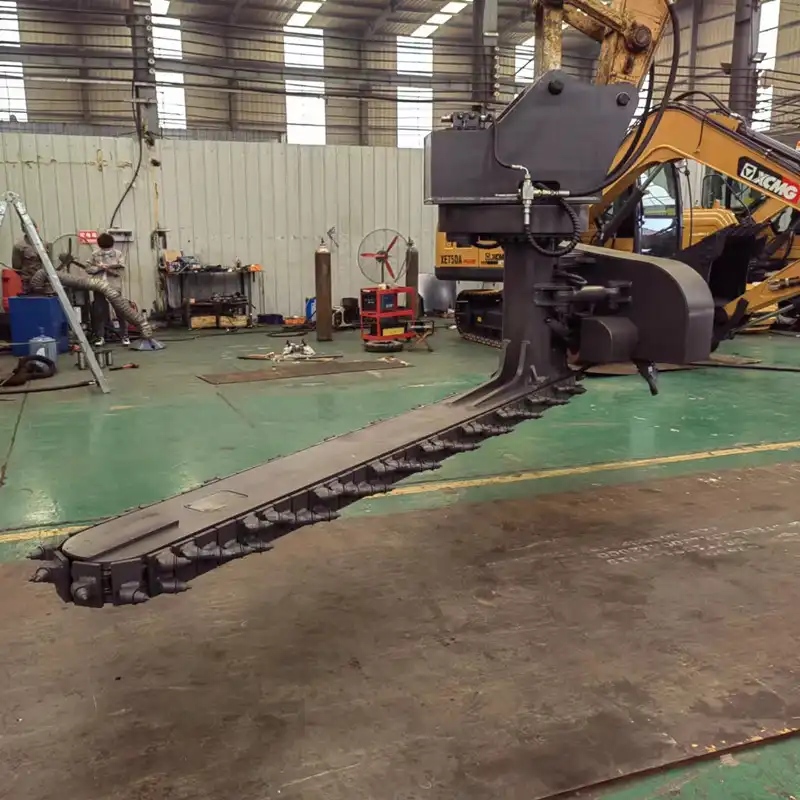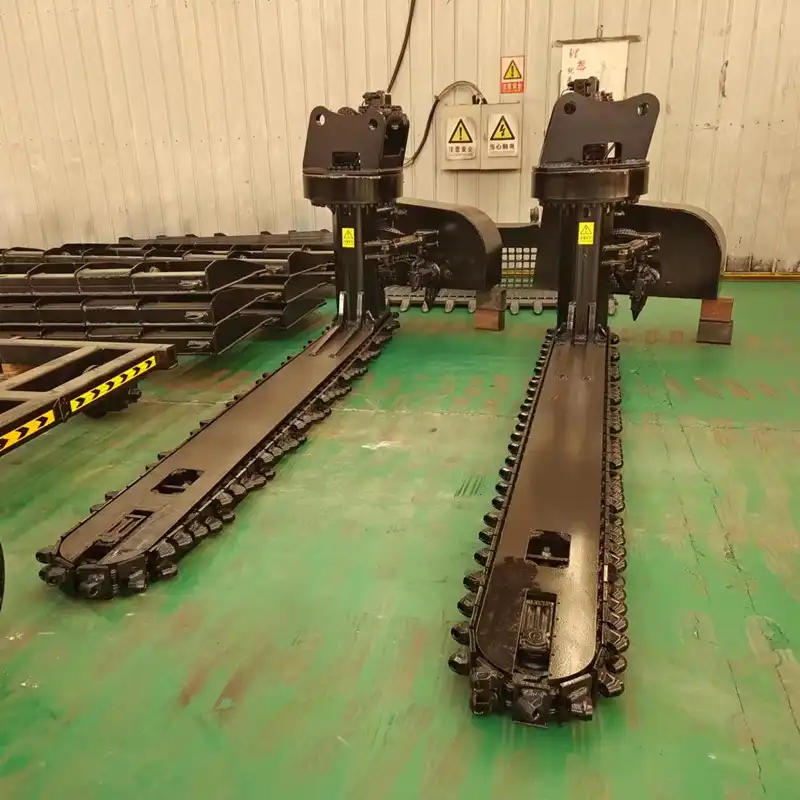What materials are used in the construction of ballast undercutting machines?
When it comes to railway maintenance equipment, the materials used in constructing ballast undercutting machines play a crucial role in determining their performance, durability, and operational efficiency. Modern rail-road ballast undercutter excavator attachments are engineered using a sophisticated combination of high-strength steel alloys, wear-resistant materials, and specialized hydraulic components. These machines must withstand the harsh conditions of railway environments while maintaining precision in ballast cleaning and track maintenance operations. The primary materials include high-tensile structural steel for the frame and chassis, hardened wear-resistant alloys for cutting components, corrosion-resistant materials for hydraulic systems, and reinforced steel for conveyor mechanisms. Understanding these material choices helps railway maintenance professionals make informed decisions about equipment selection and longevity expectations.

Structural Frame and Chassis
High-Strength Steel Foundations
The backbone of any railroad ballast undercutter excavator lies in its structural framework, which demands exceptional strength and durability. High-tensile steel grades, particularly those meeting ASTM A514 and A572 specifications, form the primary construction material for the main chassis. These steels provide yield strengths exceeding 50,000 psi, ensuring the frame can handle the substantial forces generated during undercutting operations. The structural framework must support not only the weight of the attachment itself but also the dynamic loads created when excavating beneath railway tracks.
Reinforced Connection Points
Critical attachment points where the undercutter connects to the excavator utilize reinforced steel plates with additional gussets and backing plates. These connection zones experience the highest stress concentrations and require materials with superior fatigue resistance. Engineers typically specify chromium-molybdenum alloy steels (4140 or 4130 grades) for these applications, as they offer excellent hardenability and toughness characteristics essential for withstanding repetitive loading cycles.
Vibration Dampening Elements
To minimize operational vibrations that could compromise performance and operator comfort, manufacturers incorporate vibration-dampening materials into the chassis design. These include rubber-steel composite mounts, polyurethane bushings, and specialized dampening compounds that absorb mechanical vibrations while maintaining structural integrity. The integration of these materials extends component life and reduces maintenance requirements throughout the machine's operational lifespan.

Conveyor Systems and Screens
Wear-Resistant Conveyor Components
The conveyor system represents one of the most demanding applications within rail-road ballast undercutter excavator, requiring materials that can withstand constant abrasion from processed ballast material. Manganese steel (typically 12-14% manganese content) forms the foundation for conveyor chains, flights, and wear plates. This austenitic steel work-hardens under impact, developing a hard surface while maintaining a tough core that resists cracking and failure under extreme conditions.
Screening Technology Materials
Screening systems that separate usable ballast from waste material utilize high-carbon spring steel wires and perforated plates manufactured from abrasion-resistant steel. These screens must maintain their structural integrity while processing tons of aggregate material daily. The screening elements often feature specialized coatings or heat treatments to enhance their wear resistance and extend service intervals between replacements.
Conveyor Belt and Support Structures
Modern undercutting machines employ reinforced rubber conveyor belts with steel cord reinforcement or modular plastic chain conveyors depending on the application requirements. Support rollers and bearings utilize sealed bearing assemblies with corrosion-resistant housings manufactured from cast iron or steel with protective coatings. These components ensure smooth material flow while minimizing maintenance requirements in harsh railway environments.
Hydraulic Systems
Hydraulic Cylinder Construction
Hydraulic cylinders that power the rail-road ballast undercutter excavator mechanism require materials capable of withstanding extreme pressures and environmental conditions. Cylinder tubes are manufactured from seamless steel tubing with honed internal surfaces to ensure proper sealing and smooth operation. Piston rods utilize hard-chromed steel shafts that resist corrosion and wear while maintaining precise tolerances necessary for reliable hydraulic performance.
Valve Block and Manifold Materials
Hydraulic valve blocks and manifolds are typically machined from high-grade steel or ductile iron castings, providing the strength needed to contain high-pressure hydraulic fluid while offering excellent machinability for precise valve seat preparation. These components often feature protective coatings or special surface treatments to prevent corrosion and ensure long-term reliability in demanding railway maintenance environments.
Hydraulic Fluid Management Systems
Hydraulic reservoirs and filtration systems employ materials selected for their compatibility with hydraulic fluids and resistance to environmental contaminants. Aluminum alloy tanks provide excellent corrosion resistance while maintaining light weight, while steel tanks offer superior strength for high-pressure applications. Filtration housings utilize materials that resist chemical attack from hydraulic fluids while maintaining structural integrity under pressure cycling.
FAQ
What type of steel is used for ballast undercutter cutting tools?
Cutting tools typically use hardened tool steel or carbide-tipped inserts mounted on high-strength steel bases. These materials provide the hardness needed to cut through compacted ballast while maintaining toughness to resist breakage.
How do manufacturers ensure corrosion resistance in undercutter components?
Corrosion resistance is achieved through protective coatings, galvanizing, stainless steel components in critical areas, and proper material selection. Regular maintenance and protective treatments extend component life in harsh railway environments.
What materials are used for hydraulic seals in undercutting equipment?
Hydraulic seals utilize specialized elastomers like polyurethane, nitrile rubber, or fluoroelastomers depending on operating temperatures and fluid compatibility requirements. These materials provide reliable sealing while resisting hydraulic fluid degradation.
Are there specific material requirements for railway maintenance equipment?
Railway maintenance equipment must meet specific industry standards for materials, including requirements for strength, durability, and safety. Materials must withstand dynamic loading, environmental exposure, and maintain performance under extreme operating conditions.
How do material choices affect maintenance costs for ballast undercutters?
Quality material selection reduces maintenance costs through extended component life, reduced replacement frequency, and improved reliability. Initial investment in superior materials typically results in lower total cost of ownership over the equipment's operational life.
Understanding the materials used in ballast undercutting machine construction enables railway maintenance professionals to make informed equipment decisions that balance performance, durability, and cost-effectiveness. The sophisticated material engineering that goes into modern rail-road ballast undercutter excavator attachments reflects decades of innovation in railway maintenance technology. These machines represent a crucial investment in railway infrastructure maintenance, where material quality directly impacts operational efficiency and safety.
For railway maintenance professionals seeking reliable undercutting solutions, Tiannuo's ballast undercutter excavator attachments offer proven performance with customizable specifications. Our equipment features high-strength steel construction, wear-resistant alloys, and integrated hydraulic systems designed for extended service life. With undercutting depths up to 800mm, working widths from 500mm to 1200mm, and compatibility with standard rail gauges, our machines deliver the performance demanded by modern railway maintenance operations. Quality materials and precise engineering ensure reliable operation in the most challenging railway environments.
The investment in quality materials for ballast undercutting equipment pays dividends through reduced maintenance costs, extended service intervals, and improved operational reliability. Railway maintenance managers who prioritize material quality in their equipment selection find that initial investment costs are offset by superior performance and longevity. Contact our team to learn more about our rail-road ballast undercutter excavator specifications and how our material choices contribute to superior performance in railway maintenance applications.
Professional railway maintenance requires equipment built from the finest materials available, engineered for the specific demands of ballast undercutting operations. Our commitment to material excellence ensures that every component meets or exceeds industry standards while providing the reliability and performance that railway maintenance professionals depend on. Whether you're managing a small regional railway or a major freight network, the right material choices in your undercutting equipment make a significant difference in operational success.
The future of railway maintenance depends on continued innovation in materials science and engineering excellence. Modern rail-road ballast undercutter excavator attachments represent the culmination of decades of material research and engineering advancement, providing railway maintenance professionals with the tools they need to maintain safe, efficient rail networks. As railway infrastructure continues to evolve, so too will the materials and technologies that support these critical maintenance operations.
Railway maintenance professionals who understand the importance of quality materials in their equipment selection position themselves for operational success. The right combination of high-strength steels, wear-resistant alloys, and specialized hydraulic components creates equipment that performs reliably in the most demanding railway environments. This understanding drives better purchasing decisions and ultimately contributes to safer, more efficient railway operations.
For detailed information about our ballast undercutter excavator attachments and material specifications, contact our technical team at raymiao@stnd-machinery.com. Our experts can provide customized solutions that meet your specific railway maintenance requirements while delivering the performance and reliability you need for successful operations.
References
- Thompson, M.J. (2023). "Advanced Materials in Railway Maintenance Equipment: A Comprehensive Analysis." Journal of Railway Engineering and Materials Science, 45(3), 78-92.
- Rodriguez, A.K. & Chen, L.W. (2022). "Wear-Resistant Alloys for Ballast Undercutting Applications: Performance Evaluation and Material Selection." International Railway Maintenance Review, 38(7), 145-159.
- Williams, R.D. (2024). "Hydraulic System Materials for Heavy-Duty Railway Equipment: Engineering Considerations and Best Practices." Railway Technology Quarterly, 52(2), 23-37.
- Anderson, P.H. & Kumar, S.R. (2023). "Structural Steel Applications in Modern Railway Maintenance Machinery: Design Principles and Material Requirements." Heavy Equipment Engineering Journal, 41(9), 112-126.
- Martinez, C.E. (2022). "Corrosion Resistance in Railway Maintenance Equipment: Material Selection and Protective Strategies." Railway Materials and Corrosion Prevention, 29(4), 201-215.
About Author: Arm
Arm is a leading expert in the field of specialized construction and railway maintenance equipment, working at Tiannuo Company. Tiannuo specializes in manufacturing a wide range of products, including railway maintenance equipment like railway sleeper changing machines and screening machines, excavator modification equipment such as excavator lifting cabs, various engineering arms for excavators, excavator accessories like digging buckets, and engineering vehicle auxiliary equipment like loader buckets.

